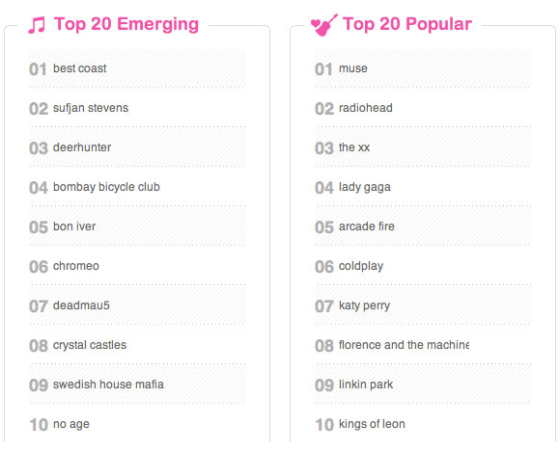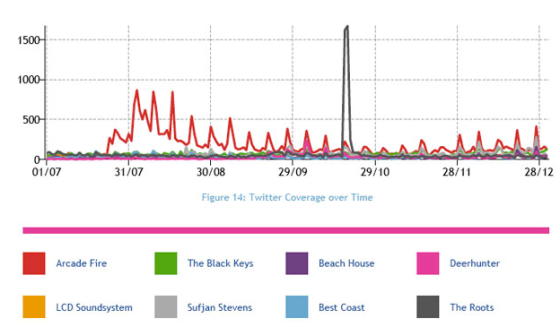Since the dawn of the Internet, the music industry and music culture has changed significantly. In the increasingly inter connected media web we live with today, social media tools have no doubt significantly impacted the way we communicate, interact, share, and consume information. Accordingly, as music culture has followed many of these same trends and shifts, social media tools have become an essential part of today’s music culture.
Author Henry Jenkins argues that we live in a convergence culture today, describing this as “the flow of content across multiple media platforms, the cooperation between multiple media industries, and the migratory behavior of media audiences who will go almost anywhere in search of the kinds of entertainment experiences they want”(Jenkins, 2008). This content movement across multiple platforms is very important to the way music culture utilizes social media. Music artists’ do not have just one outlet for sharing information and music but instead communicate over several different social media platforms, often linking content of one to another, this encouraging encouraging broader followership and participation while also ensuring content is delivered in a variety of ways to audiences. For example, music artists often tweet pictures that were taken using Instagram, such as the below Taylor Swift tweeted picture. This practice lets Twitter followers know that if desired they can also follow the artist on Instagram. More importantly thought, this shows music artists are actively overlapping content from different social media platforms in order to deliver content in the way their audience desires. In this case, Taylor’s audience of Twitter followers were delivered Instagram style pictures without having to leave Twitter.
The effectiveness in music culture of using multiple media platforms can be seen looking at the findings of a report done by the online music chart We Are Hunted which looked at popular music in the last half of 2010. The study analyzed data they collected from social networks, Twitter, blogs, forums and more (MacManus, 2011).
In the report, the band Arcade Fire, coming in as #5 on the top popular list, was the only new entrant to the top five for the second half of 2010. This is interesting since the band was not even in the top ten six months earlier. As We Are Hunted co-founder and CTO Stephen Phillips put it, “Arcade Fire went mainstream in a big way in the last half of 2010”(MacManus, 2011). The study showed that in July the band’s Twitter activity peeked in anticipation of the release of their new album, The Suburbs, that August. This would suggest “the band was very well hyped prior to the album’s release”(MacManus, 2011). Studying their social media activity shows comprehensive online promotion for the album, using both Facebook and Twitter for this purpose, although the actual band members themselves didn’t “appear to be active on these social media sites”(MacManus, 2011). Arcade Fire also has its own YouTube and Vimeo channels. While it has become a necessity and standard practice for music artists to have Twitter and a Facebook page, it is not necessarily an assumed standard practice that they have their own YouTube and/or Vimeo channels. Arcade Fire’s established presence over multiple social media platforms ensures that they are communicating and/or providing entertainment experiences in a variety of ways, enabling them to better reach a broader audience. Arcade Fire’s effective use of several different social media platforms as a promotional tool for new music is an example of music culture adapting to convergence culture.
In convergence culture, a significant force in the circulation of media content is the active participation of consumers, Jenkins arguing that this convergence represents “a cultural shift as consumers are encouraged to seek out new information and make connections among dispersed media content”(Jenkins, 2008). Instead of the former ways of passive media spectatorship, Jenkins argues there is a participatory culture today in which media producers and consumers both participate and interact with each other (Jenkins, 2008). Jenkins argues in his spreadability model that “consumers play an active role in “spreading” content… their choices, their investments, their actions determine what gets valued in the new mediascape”(Jenkins, 2009). This may be true in the new participatory culture, but still, not all participants are equal. Jenkins points out, “Corporations–and even individuals within corporate media–still exert greater power than any individual consumer or even the aggregate of consumers. And some consumers have greater abilities to participate in this emerging culture than others”(Jenkins, 2008). The idea that certain participants have more power seems to stand true in music culture. Looking again at the We Are Hunted report, their research found the trend that “the music press – traditional magazines as well as online sites like Pitchfork – have a lot of sway in generating social media buzz”(MacManus, 2011). The specific publications We Are Hunted identified as particularly influential in creating this social media buzz included Pitchfork, Prefix Magazine, NME, Hipster Runoff, Clash Music and Spin (MacManus, 2011). Phillips explained that any of these publications would make a music artist “blow up” because when they gave coverage, the blogosphere was sure to follow (MacManus, 2011). So essentially most participants are taking cues from a few of the same main participants like Pitchfork and Spin. Even though in music culture convergence brings a new participatory culture, not all participants are equal as there are a few participants with significantly more influence on the overall music related conversations seen in social media.
Despite this inequality, there is still a strong sense of a participatory culture among consumers. With more participation from more participants there is also more communication and knowledge being shared as participants make connections in today’s web of media content. An important part of making these connections is that participants usually get information not from a solitary source but from multiple participants. As Jenkins explains, “None of us know everything; each of us knows something; and we can put the pieces together if we pool our resources and combine our skills”(Jenkins, 2008). From this comes the concept of collective intelligence which refers to the way “consumption has become a collective process”(Jenkins, 2008). Creating a pool of collective intelligence is usually more efficient when interacting in a social media community of participants interested in the same type of information. “Knowledge communities form around mutual intellectual interests; their members work together to forge new knowledge often in realms where no traditional expertise exists; the pursuit of and assessment of knowledge is at once communal and adversarial”(Jenkins, 2008). Music culture in social media is no exception to this trend.
In music culture, Rap Genius is an example of collective intelligence at work using social media. RapGenius.com acts as a guide to the meaning of rap lyrics as a site where a person can listen to a song, read its lyrics, and read explanations and/or critics of the specific lines within the song. If a person is interested in a particular line of a song, they can click on the line and get a pop up explanation. The “About Rap Genius” page explains that the site’s “aim is not to translate rap into “nerdspeak”, but rather to critique rap as poetry”(“What is rap genius,” n.d.). These critics and explanations come from the site’s many contributors and anyone can create an account to start participating. Some song lines have several different explanations listed from several different users contributing and it is common for contributors to include relevant pictures and links in their explanations.
“Highlight any line to explain it yourself, suggest changes to existing explanations, and put up your favorite new songs. If you make good contributions you’ll earn Rap IQ™, and if you spit true knowledge, eventually you’ll be able to edit anything on the site.. just like a hip-hop Wikipedia” (“What is rap genius,” n.d.). This is a clear example of music culture using social media to create a knowledge community to pool information form many active participants and build their collective knowledge.
Here, people who care and are knowledgeable about a specific topic or interest area have used social media to form a virtual community to pool their knowledge and reap the benefits of collective intelligence. In the case of Rap Genius, the virtual community was formed by rap music fans and their mutual interests in rap lyrics. Author Howard Rheingold defines virtual communities as “social aggregations that emerge from the Net when enough people carry on those public discussions long enough, with sufficient human feeling, to form webs of personal relationships in cyberspace”(Rheingold, 2000). Rheingold’s own first experience in a virtual community began in 1985 with the WELL (Whole Earth ‘Lectronic Link). He describes his experience saying, “I was audience, performer, and scriptwriter, along with my companions, in an ongoing improvisation. A full-scale subculture was growing… and they invited me to help create something new” (Rheingold, 2000). Although Rheingold’s observations emphasize the importance of personal relationships in virtual communities, personal relationships appear to be less crucial in music related virtual communities. Generally, developing personal relationships is not a particularly significant part of most of today’s music related virtual communities as they are highly focused on their mutual interest (specific band, music artist, music genre) and communication and information sharing related specifically to this. These communities have focus and come together to benefit from the group’s knowledge capital and collective intelligence concerning their specific shared interest. Although personal relationships may not be key, there is a sense of community in their common interest and appreciation for one another’s contribution to the group. Displays of this appreciation could be as simple as a participant posting a relevant picture to the Facebook fan page of a band and many of the other fans “liking” and/or commenting on the post, such as the post shown below from the band Empire of the Sun Facebook fan page.
Facebook fan pages and other social media tools facilitate virtual communities in music culture allowing the music artists themselves to interact and share information among one another. These platforms are important as they give music artists the opportunity to interact with and get direct feedback from large amounts of their fans almost instantly on a consistent basis that was not possible in the past. Just as with social media we have seen new shifts and trends in the way we communicate and exchange information as participants and virtual community members, Music culture has seen many of the same transformations.






